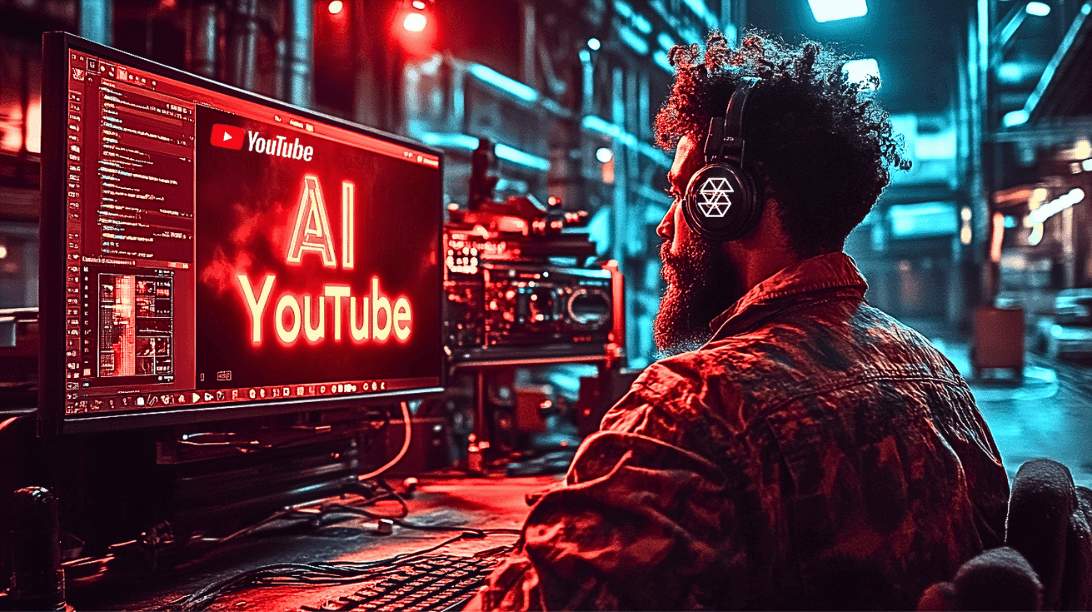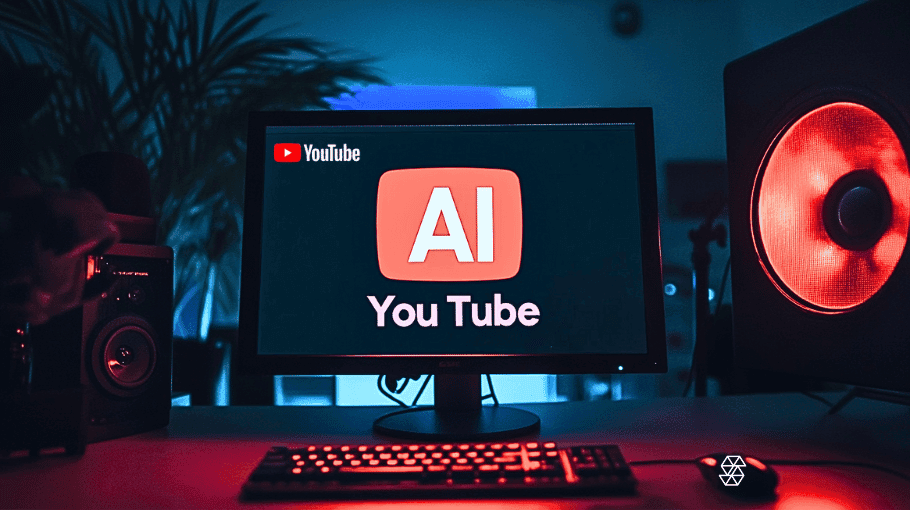Why Adobe is Set to Crush It This Year: Generative AI, Copyright-Guaranteeing Models, Massive User Base

Adobe has been a leader in the creative software industry for decades. Known for its innovation and user-friendly creative tools, Adobe has remained a market leader, offering solutions that enable millions to engage in content creation, design, image editing, video editing, and digital marketing. But why are they set to crush it this year more than ever? The secret lies in a trinity of strengths: Adobe’s generative AI, copyright-guaranteeing models, and its massive user base.
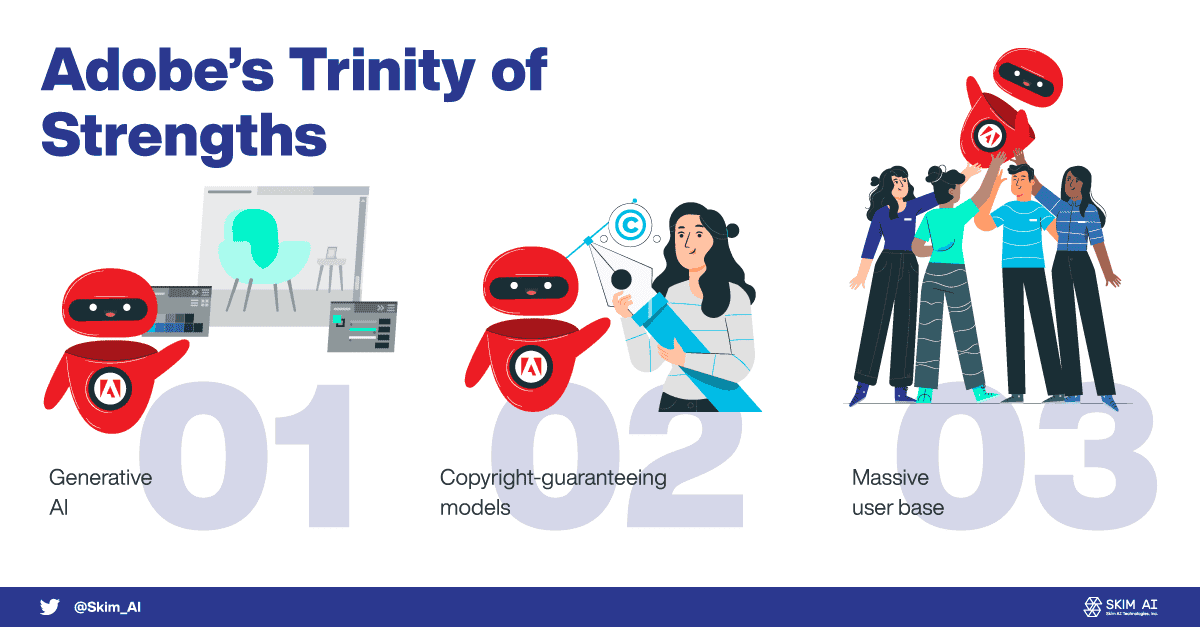
Adobe’s Copyright-Guaranteeing Models: A Competitive Moat
In the world of software development, innovation and copyright protection are intertwined, each fueling the other in a symbiotic dance that often dictates market leadership. Adobe, an undisputed titan in the creative software sector, has always excelled in both. Pioneering tools like Photoshop and Illustrator aren’t just superior in terms of their user experience; they also come with robust copyright-guaranteeing models that create a significant barrier to entry for competitors.
When we delve into Adobe’s competitive moat, their strategic handling of copyright matters becomes evident. For instance, Adobe’s Photoshop software, a gold standard in image editing, comes with unique features and functionalities that are intricately copyrighted. This isn’t just about protecting Adobe’s intellectual property—it’s about erecting high walls that keep potential competitors at bay.
Think of each Photoshop tool, each Illustrator plugin, as a brick in this defensive wall. Each functionality is a product of Adobe’s ingenuity, the result of years of research and development, and underpinned by copyright protection. Competitors cannot simply replicate these features without infringing Adobe’s copyrights, effectively barring them from Adobe’s terrain and reinforcing Adobe’s market dominance.
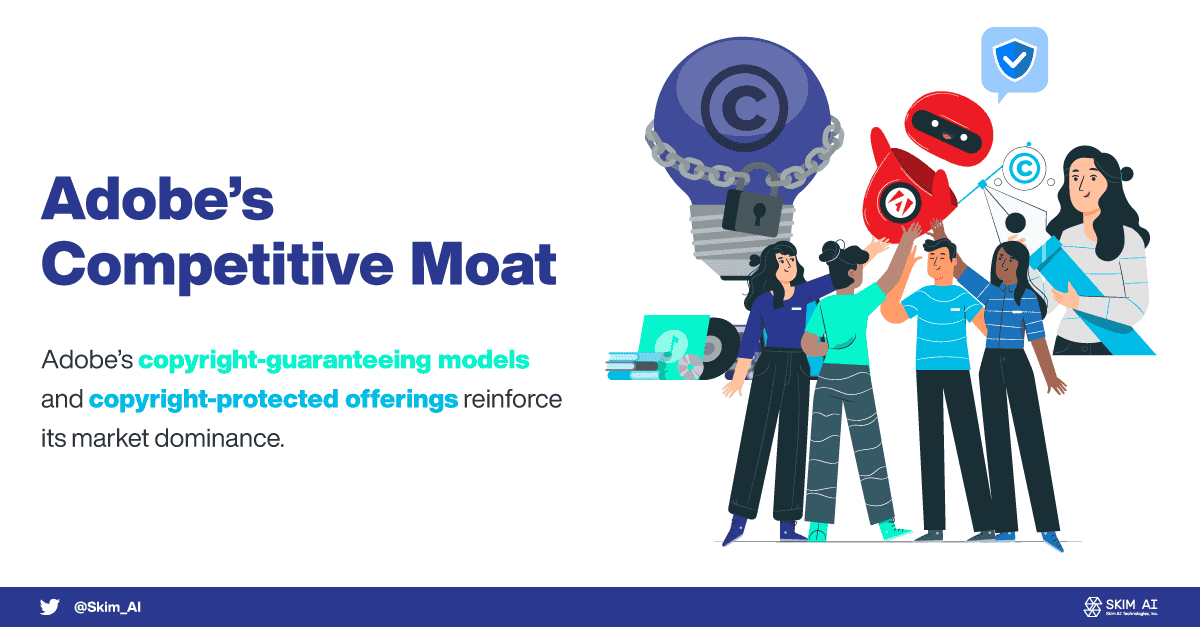
Now more than ever, this strategic copyright protection is essential. The rise of artificial intelligence and, in particular, generative AI, has prompted concerns about copyright infringement, especially concerning AI-generated images and content. Adobe, with its robust copyright-guaranteeing models, is uniquely equipped to navigate this complex landscape, mitigating potential copyright issues that may arise with the use of AI technology.
This strategy extends beyond their classic tools. With the introduction of new products and features, Adobe continues to expand its arsenal of copyright-protected offerings, further cementing its position in the market.
But what does this mean for Adobe’s future? Simply put, these copyright-guaranteeing models don’t just guard Adobe’s current competitive landscape—they also secure its future. As long as Adobe continues to innovate and fortify its offerings with strong copyright protection, it will continue to hold its enviable position in the creative software industry, even in the face of rapidly evolving AI technology.
Adobe’s Vision for Generative AI
Adobe has always been at the forefront of innovation, providing its users with tools that consistently push the boundaries of design and content creation. In their recent advancements, Adobe has taken a decisive leap into the future with the integration of generative AI into their software. This is more than an upgrade; it’s a game-changer that stands to revolutionize the creative process. The launch of Adobe’s generative AI, particularly the “Firefly” technology, encapsulates this transformation.
Adobe Firefly is the company’s new family of creative generative AI models designed to revolutionize the creative process. Integrated initially into image and text effect generation, Firefly is set to significantly improve creative workflows, offering users an entirely new way to ideate, create, and communicate. This exciting development is a natural extension of the technology Adobe has been producing over the past four decades. It’s driven by Adobe’s enduring belief that people should be empowered to manifest their ideas into the world exactly as they envision them.

Adobe Firefly’s generative AI features
But what sets Firefly apart in the realm of generative AI? Unlike typical AI text-to-image generators, Firefly promises to be much more. Envisioned as part of the Adobe Creative Cloud, Firefly is set to augment Adobe’s suite of creative tools, with a text-based interface for generating and editing diverse media, from still images to videos, and even 3D objects. It will also offer “creative building blocks” such as brushes, vectors, textures, and more, drastically expanding the possibilities for creative exploration.
The ultimate vision for Firefly extends beyond its current capabilities. Adobe envisions a future where creators can use everyday language and other inputs to swiftly test design variations, remove distractions from photos, add elements to illustrations, alter the mood of a video, add texture to 3D objects, and create immersive digital experiences. This blend of AI and creativity will allow creators to customize and edit their content seamlessly using Firefly in conjunction with other Creative Cloud tools.
The current iteration of the Firefly generative AI model has been trained on a dataset comprising Adobe Stock, openly licensed work, and public domain content whose copyright has expired. This training provides the model with a vast array of stylistic and thematic variations, thereby enabling it to cater to a wide range of creative needs.
However, the evolution of Firefly doesn’t stop there. Adobe is exploring ways for creators to train the machine learning model with their own assets. This would allow them to generate content that matches their unique style, branding, and design language, without the influence of other creators’ content. This development promises to further enhance the user experience by offering a level of personalization that was previously unattainable.
Adobe’s Generative AI, embodied in technologies like Firefly, represents a paradigm shift in how we perceive and interact with AI in creative processes. It stands as a testament to Adobe’s commitment to innovation and user empowerment, setting the stage for an even more exciting future for the world of design and content creation.
How Adobe Will Harness and Grow Its Massive User Base
Adobe has always excelled at maintaining a strong user base. This is largely due to its high-quality software, unparalleled user experience, and innovative suite of creative tools. Adobe’s Creative Cloud is a case in point. It boasts a robust user base of an estimated 30 million paid subscribers. This colossal user base is a testament to Adobe’s widespread appeal and the value that its products offer to creators.
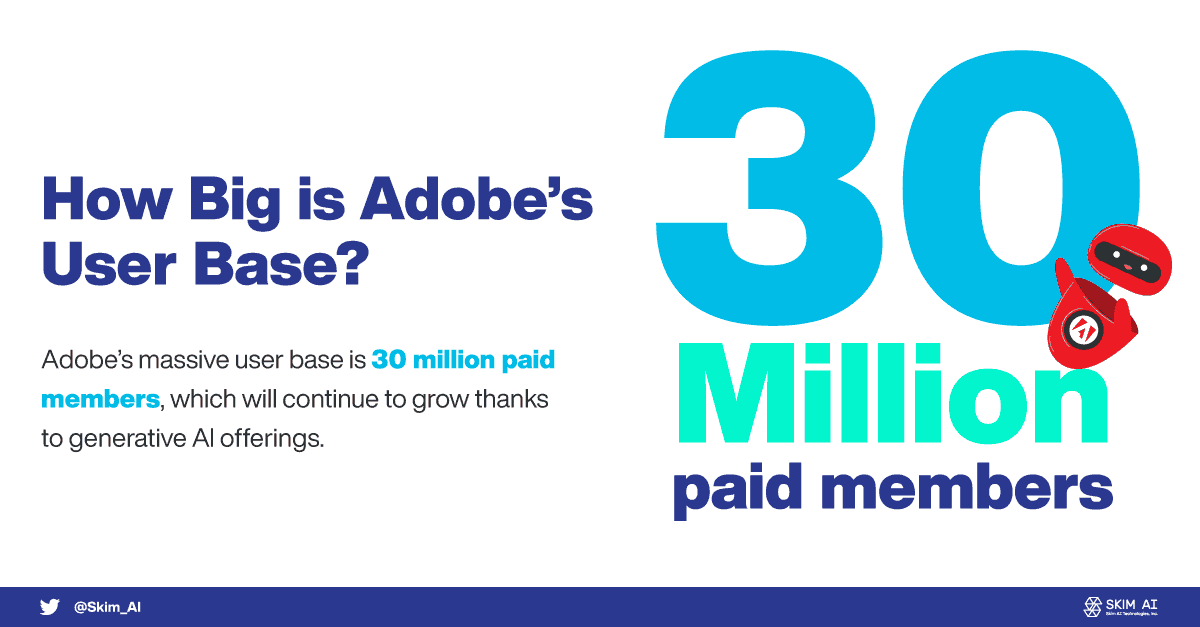
However, the rise of Adobe’s generative AI tools represents a tectonic shift in Adobe’s potential for user growth. With the advent of technologies like Firefly, Adobe is poised to redefine what it means to be a content creator in the digital age. These tools, powered by generative AI, offer unprecedented levels of automation, personalization, and creative potential.
Given the sheer scope of applications that generative AI opens up, Adobe’s Creative Cloud is set to attract a broad range of users. From graphic designers seeking to experiment with new styles, to digital marketers looking for ways to streamline their content production processes, to artists exploring the frontier of digital creation, Adobe’s generative AI tools offer something for everyone.
Moreover, Adobe’s plan to allow users to train Firefly with their own assets promises to provide an unparalleled level of personalization. This feature alone is likely to draw in users who are seeking a platform that allows them to bring their unique creative visions to life with precision and ease.
But the appeal of Adobe’s generative AI tools extends beyond professional creators. These tools have the potential to democratize content creation, making it more accessible to those with little or no experience in design. By simplifying the creative process and removing technical barriers, Adobe is set to tap into a vast pool of potential users who were previously deterred by the complexities of traditional design software.
In essence, the advent of Adobe’s generative AI tools is likely to catalyze an unprecedented surge in its user base. Given Adobe’s track record of capitalizing on technological innovation to offer its users powerful creative tools and an unparalleled user experience, the prospects for user growth are promising. Indeed, the rise of Adobe’s generative AI may represent the greatest leap forward in Adobe’s history, laying the groundwork for a surge in user growth that could well exceed current expectations.
The Symbiosis of Copyrights, Users, and AI
The intersection of Adobe’s advanced copyright-guaranteeing models, its expansive user base, and the rise of transformative generative AI technologies forms a powerful trifecta that sets Adobe apart in the creative software industry. This unique combination is what makes Adobe’s position in the market not just formidable, but poised for substantial growth and innovation.
Adobe’s copyright-guaranteeing models offer users peace of mind and establish a distinct competitive moat that separates Adobe from the competition. This has been instrumental in fostering the loyalty of its existing user base and attracting new users, especially in an era where AI-generated content has raised new concerns about copyright infringement.
Simultaneously, Adobe’s user base, already massive, stands on the precipice of exponential growth driven by the introduction of its generative AI tools. These advanced technologies are redefining the creative process, offering personalization and automation that allows both experienced designers and novices to realize their creative visions more effectively. As these technologies continue to evolve and refine, they are likely to draw in even more users, thereby strengthening Adobe’s market dominance.
Adobe’s foray into generative AI is pushing the boundaries of what’s possible in design and content creation. Tools like Firefly are just the beginning. They represent a future where creativity is unbound by traditional constraints, where unique ideas can be brought to life with unprecedented precision and efficiency.
The symbiosis of these three factors — copyrights, users, and AI — is more than just a competitive advantage; it is a catalyst for an evolution in the creative industry. As we look forward to the rest of the year and beyond, it’s clear that Adobe’s dedication to innovation, its unwavering commitment to its users, and its visionary approach to incorporating AI into its product suite make it a company that’s more than equipped to ‘crush it’.





